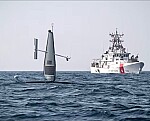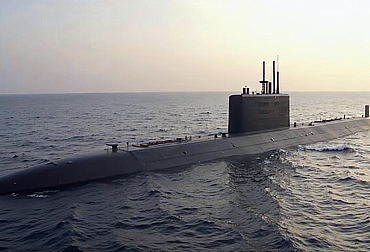Australia’s largest-ever industrial mobilization: Submarines, missiles, and Honeywell’s pivotal role
Australia is currently undergoing its most extensive and significant industrial mobilization in modern history, driven by two monumental defense programs. The first is the AUKUS nuclear-powered submarine initiative, a trilateral agreement between Australia, the United Kingdom, and the United States. The second is the Guided Weapons and Explosive Ordnance (GWEO) Enterprise, designed to enhance Australia’s capabilities in missile technology and ordnance production.

In the midst of these transformative projects, Honeywell, a global leader in aerospace and industrial technology, is playing a critical role. Honeywell's contribution spans across multiple defense platforms and sectors, supporting Australia’s efforts to build sovereign defense capabilities. This article delves into an interview with Lee Davis, Honeywell Australia’s defense and space leader, where he outlines Honeywell’s history, its current efforts, and its crucial role in these defense mobilizations.
Honeywell’s long-standing presence in Australia
Honeywell has been operating in Australia since 1962, establishing a robust footprint across every state and territory. With over 1,700 employees and 25 locations throughout the country, Honeywell has deep ties to Australian industry and defense. Davis emphasizes that Honeywell’s presence is diverse, with capabilities spanning air, land, and sea platforms.
For six decades, Honeywell has provided critical support to the Australian Defence Force (ADF), contributing a wide array of technologies, including navigation, guidance, power systems, avionics, and oxygen systems. These technologies are integral to the Royal Australian Air Force (RAAF), Navy, and Army. Davis notes that Honeywell’s components are present in every ADF aircraft platform, from the F-35 fighter jets to general aviation aircraft used for training.
Supporting the ADF: From F-35s to Abrams tanks
Honeywell’s defense contributions go beyond its own products; the company collaborates with prime contractors like Lockheed Martin and Boeing, providing key systems for platforms like the F-35 Joint Strike Fighter (JSF) and the F/A-18 Super Hornet. In addition, Honeywell partners with small-to-medium enterprises (SMEs) like TAE Aerospace and Rosebank Engineering, transferring technology to enable local repair and maintenance (MRO) of defense assets. This collaboration ensures that essential equipment, such as the Abrams battle tank’s Honeywell-manufactured engine, can be serviced locally.
AUKUS: Australia’s largest industrial endeavor
The AUKUS submarine program stands as Australia’s largest and most complex industrial venture to date. This program will require approximately 30,000 workers and involve a massive expansion of Australia’s industrial base. Honeywell’s involvement in AUKUS is multifaceted, leveraging its experience in supporting submarine programs in the U.S. and U.K. Davis highlights that Honeywell already provides critical components like navigation and actuation systems for submarines, and its expertise extends into nuclear stewardship, infrastructure security, and industrial security.
Honeywell’s experience in nuclear programs—particularly in the U.S., where it has supported nuclear defense sites for over 75 years—positions it as a key player in Australia’s AUKUS submarine program. The company is well-equipped to support the infrastructure security of Australia’s existing and new submarine bases, as well as manage the supply chain for critical components. Furthermore, Honeywell’s expertise in nuclear waste management is an additional area where it could support Australia’s submarine industry.
GWEO: Advancing Australia’s missile capabilities
In addition to AUKUS, the GWEO Enterprise represents another significant industrial mobilization, focusing on guided weapons and ordnance production. Honeywell’s role in this space is crucial, as its components are found in over 80% of the missile platforms being procured by Australia, including missiles from Lockheed Martin and Raytheon.
Honeywell is already contributing to the Guided Multiple Launch Rocket System (GMLRS), which is a priority for Australia’s military. The Australian government has initiated a contract with Lockheed Martin to begin assembling GMLRS rounds locally, with Honeywell providing essential components for this program. Davis outlines Honeywell’s approach to enhancing Australia’s missile capabilities, starting with the ability to test and calibrate guidance systems in-country, followed by repair, modification, and eventually local production of missile components.
Expanding sovereign capability and securing supply chains
One of the key goals of Australia’s defense mobilization is to develop sovereign capability, reducing reliance on foreign suppliers. Honeywell is playing a pivotal role in achieving this objective by working with local partners to establish repair and production capabilities for critical defense components. This strategy not only strengthens Australia’s defense infrastructure but also secures supply chains, which have become increasingly vulnerable due to global disruptions.
Davis points out that Honeywell’s expertise in guidance and navigation systems is particularly relevant to the GWEO Enterprise. By establishing local capabilities for testing and calibrating these systems, Honeywell is laying the foundation for future missile assembly and production in Australia. This approach aligns with the government’s broader goal of ensuring that critical defense assets can be sustained domestically.
Supporting future platforms: Apache helicopters, space, and UAS
Honeywell’s involvement in Australian defense extends beyond submarines and missiles. The Australian Army’s upcoming Apache attack helicopters will benefit from Honeywell’s experience in supporting other rotary platforms like the Chinook. Davis highlights that Honeywell’s components, such as auxiliary power units and navigation systems, are common across multiple platforms, enabling the company to support the Apache in a similar manner.
In the space and unmanned aerial systems (UAS) sectors, Honeywell’s legacy is equally impressive. Having supported every crewed NASA mission since the Apollo program, Honeywell is well-positioned to contribute to Australia’s first sovereign military satellite program, JP 9102. The company is already working with Lockheed Martin, the prime contractor for the program, to provide critical satellite and ground-station components.
Honeywell is also supporting Boeing’s Ghost Bat UAS development program, which is expected to play a key role in Australia’s future defense strategy. As space and UAS technologies continue to evolve, Honeywell’s expertise in these areas will become increasingly important to Australia’s defense landscape.
Conclusion: Honeywell’s integral role in Australia’s defense future
Honeywell’s six-decade presence in Australia has positioned it as a key partner in the country’s largest-ever industrial mobilization. From submarines and missiles to helicopters and space systems, Honeywell’s products and expertise are integral to Australia’s defense capabilities. As the AUKUS and GWEO programs progress, Honeywell’s commitment to enhancing local capability and securing supply chains will ensure that Australia’s defense infrastructure remains robust and resilient for years to come.
In Lee Davis’ words, “If you look inside any defense asset in-country, it’s highly likely to have Honeywell inside.”








